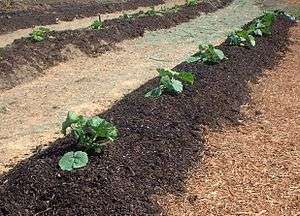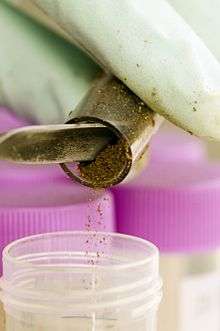Biosolids
Biosolids is a term used for several types of treated sewage sludges that can be used as soil conditioner.[1] Treated sewage sludge has long been used in agriculture.[2]

Terminology
Biosolids may be defined as organic wastewater solids that can be reused after suitable sewage sludge treatment processes leading to sludge stabilization such as anaerobic digestion and composting.[3]
Alternatively, the biosolids definition may be restricted by local regulations to wastewater solids only after those solids have completed a specified treatment sequence and/or have concentrations of pathogens and toxic chemicals below specified levels.[4]
The United States Environmental Protection Agency (EPA) defines the two terms – sewage sludge and biosolids – in the Code of Federal Regulations (CFR), Title 40, Part 503 as follows: Sewage sludge refers to the solids separated during the treatment of municipal wastewater (including domestic septage), while biosolids refers to treated sewage sludge that meets the EPA pollutant and pathogen requirements for land application and surface disposal.[4] A similar definition has been used internationally, for example in Australia.[5]
Use of the term "biosolids" may officially be subject to government regulations. However, informal use describes a broad range of semi-solid organic products produced from sewage or sewage sludge. This could include any solids, slime solids or liquid slurry residue generated during the treatment of domestic sewage including scum and solids removed during primary, secondary or advanced treatment processes.[6] Materials that do not conform to the regulatory definition of "biosolids" can be given alternative terms like "wastewater solids".
Characteristic
Quantities

Approximately 7.1 million dry tons of biosolids were generated in 2004 at approximately 16,500 municipal wastewater treatment facilities in the United States.[7]
In the United States, as of 2013 about 55% of sewage solids are turned into fertilizer.[8] Challenges faced when increasing the use of biosolids include, the capital needed to build anaerobic digesters and the complexity of complying with health regulations. There are also new concerns about micro-pollutions in sewage (e.g. environmental persistent pharmaceutical pollutants) which make the process of producing high quality biosolids complex.[9] Some municipalities, states or countries have banned the use of biosolids on farmland.[9]
Nutrients
Encouraging agricultural use of biosolids is intended to prevent filling landfills with nutrient-rich organic materials from the treatment of domestic sewage that might be recycled and applied as fertilizer to improve and maintain productive soils and stimulate plant growth.[7] Biosolids can be an ideal agricultural conditioner and fertilizer[10] which can help promote crop growth to feed the increasing population. Biosolids may contain macronutrients nitrogen, phosphorus, potassium and sulphur with micronutrients copper, zinc, calcium, magnesium, iron, boron, molybdenum and manganese.[5]
Industrial and man-made contaminants
The United States Environmental Protection Agency (EPA) and others have shown that biosolids can contain measurable levels of synthetic organic compounds, radionuclides and heavy metals.[5][11][12] EPA has set numeric limits for arsenic, cadmium, copper, lead, mercury, molybdenum, nickel, selenium, and zinc but has not regulated dioxin levels.[7][13]
Contaminants from pharmaceuticals and personal care products and some steroids and hormones may also be present in biosolids.[14] Substantial levels of persistent, bioaccumulative and toxic (PBT) polybrominated diphenyl ethers were detected in biosolids in 2001.[15]
The United States Geological Survey analyzed in 2014 nine different consumer products containing biosolids as a main ingredient for 87 organic chemicals found in cleaners, personal care products, pharmaceuticals, and other products. These analysis detected 55 of the 87 organic chemicals measured in at least one of the nine biosolid samples, with as many as 45 chemicals found in a single sample.[16]
In 2014, the City of Charlotte, North Carolina discovered extreme levels of PCB's in their biosolids after being alerted by that illegal PCB dumping was taking place at regional waste water treatment plants across the state.[17]
Biosolids land application in South Carolina was halted in 2013 after an emergency regulation was enacted by the South Carolina Department of Health and Environmental Control (SCDHEC) that outlawed any PCB contaminated biosolids from being land applied regardless if Class A or Class B.[18] Very soon thereafter, SCDHEC expanded PCB fish consumption advisories for nearly every waterway bordering biosolids land application fields.[19]
Pathogens
In the United States the EPA mandates certain treatment processes designed to significantly decrease levels of certain so-called indicator organisms, in biosolids.[7] These include, "...operational standards for fecal coliforms, Salmonella sp. bacteria, enteric viruses, and viable helminth ova."[20]
However, the US-based Water Environment Research Foundation has shown that some pathogens do survive sewage sludge treatment.[21]
EPA regulations allow only biosolids with no detectable pathogens to be widely applied; those with remaining pathogens are restricted in use.[22]
Different types of biosolids
- Anaerobic Digestion: Micro-organisms decompose the sludge in the absence of oxygen either at mesophilic (at 35 °C) or thermophilic (between 50° and 57 °C) temperatures.
- Aerobic Digestion: Micro-organisms decompose the sludge in the presence of oxygen either at ambient and mesophilic (10 °C to 40 °C) or auto-thermal (40 °C to 80 °C) temperatures.
- Composting: A biological process where organic matter decomposes to produce humus after the addition of some dry bulking material such as sawdust, wood chips, or shredded yard waste under controlled aerobic conditions.
- Alkaline Treatment: The sludge is mixed with alkaline materials such as lime or cement kiln dust, or incinerator fly ash and maintained at pH above 12 for 24 hours (for Class B) or at temperature 70 °C for 30 minutes (for Class A).
- Heat Drying: Either convention or conduction dryers are used to dry the biosolids
- Dewatering: The separation of the water from biosolids is done to obtain a semi-solid or solid product by using a dewatering technologies (centrifuges, belt filter presses, plate and frame filter presses, and drying beds and lagoons).[23]
Classification systems
United States
In the United States Code of Federal Regulations (CFR), Title 40, Part 503 governs the management of biosolids. Within that federal regulation biosolids are generally classified differently depending upon the quantity of pollutants they contain and the level of treatment they have been subjected to (the latter of which determines both the level of vector attraction reduction and the level of pathogen reduction). These factors also affect how they may be disseminated (bulk or bagged) and the level of monitoring oversight which, in turn determines where and in what quantity they may be applied.[24]
European Union
The European Union (EU) was the first to issue regulations for biosolids land application; this aimed to put a limit to the pathogen and pollution risk.[25] These risks come from the fact that some metabolites remain intact after waste water treatment processes.[26] Debates over biosolid use vary in severity across the EU[27] and gathering acceptance is the major hurdle facing biosolids in Europe.
History
As public concern arose about the disposal of increased volumes of solids in the United States being removed from sewage during sewage treatment mandated by the Clean Water Act. The Water Environment Federation (WEF) sought a new name to distinguish the clean, agriculturally viable product generated by modern wastewater treatment from earlier forms of sewage sludge widely remembered for causing offensive or dangerous conditions. Of three-hundred suggestions, biosolids was attributed to Dr. Bruce Logan of the University of Arizona, and recognized by WEF in 1991.[28]
Examples
- Milorganite is the trademark of a biosolids fertilizer produced by the Milwaukee Metropolitan Sewerage District.[29] The recycled organic nitrogen fertilizer from the Jones Island Water Reclamation Facility in Milwaukee, Wisconsin, is sold throughout North America, reduces the need for manufactured nutrients.
- Loop is the trademark of a biosolids soil amendment produced by the King County Wastewater Treatment Division.[30] Loop has been blended into GroCo, a commercially available compost product, since 1976. Several local farms and forests also use Loop directly.[31]
- TAGRO is short for "Tacoma Grow" and is produced by the City of Tacoma, Washington since 1991.[32][33]
- Dillo Dirt has been produced by the City of Austin, Texas since 1989.
- Biosolids are applied as fertilizer in the Central Wheatbelt of Australia as a recycling program by the Water Corporation.
See also
References
- Wang, L.K; Shammas, N.K; Hung, Yung-Tse (2007). Biosolids treatment processes. Totowa, N.J: Humana Press. ISBN 9781592599967.
- Gohil, M.B. (2000). Land Treatment of Waste Water. New Age International. p. 6. ISBN 8122412270.
- Wastewater engineering : treatment and reuse (4th ed.). Metcalf & Eddy, Inc., McGraw Hill, USA. 2003. p. 1449. ISBN 0-07-112250-8.
- "Sewage Sludge/Biosolids Program". United States Environmental Protection Agency. Retrieved 24 April 2015.
- "What are biosolids?". Australian Water Association. Archived from the original on 23 April 2015. Retrieved 24 April 2015.
- Turovskiy, Izrail S. "Biosolids or Sludge? The Semantics of Terminology". Water and Wastes Digest. Retrieved 24 April 2015.
- "Questions and Answers on Land Application of Biosolids" (PDF). Water Environment Federation. Archived from the original (PDF) on 4 April 2015. Retrieved 24 April 2015.
- Cities Turn Sewage Into 'Black Gold' For Local Farms (2013)
- Smith, S. R. (2009). Organic contaminants in sewage sludge (biosolids) and their significance for agricultural recycling. Philosophical Transactions of the Royal Society of London A: Mathematical, Physical and Engineering Sciences, 367(1904), 4005-4041
- Frank, R. (1998). The use of biosolids from wastewater treatment plants in agriculture. Environmental Management and Health, 9(4), 165-169.
- "Targeted National Sewage Sludge Survey Report". Biosolids. EPA. 2009.
- "ISCORS Assessment of Radioactivity in Sewage Sludge: Recommendations on Management of Radioactive Materials in Sewage Sludge and Ash at Publicly Owned Treatment Works" (PDF). United States Environmental Protection Agency (EPA). Interagency Steering Committee on Radiation Standards. April 2004.
- "Final Action Not to Regulate Dioxins in Land-Applied Sewage Sludge". water.epa.gov. Retrieved 2015-05-18.
- "CWA Analytical Methods: Contaminants of Emerging Concern". epa.gov. Retrieved 2017-02-25.
- Hale RC, La Guardia MJ, Harvey EP, Gaylor MO, Mainor TM, Duff WH. "Flame retardants: Persistent pollutants in land-applied sludges". Nature. 412 (6843): 140–141. doi:10.1038/35084130. PMID 11449259.
- "Land Application of Municipal Biosolids". Environmental Health - Toxic Substances. United States Geological Survey. Retrieved 24 April 2015.
- "Task force named to probe chemical dumping". Charlotte Observer. 2014-02-07.
- "DHEC Issues Emergency Regulation, Expands Investigation into PCBs Found at Water Treatment Plants". News Releases. South Carolina Dept. of Health and Environmental Control (SCDHEC). 2013-09-25.
- "Fish Consumption Advisories". Food Safety. SCDHEC. Retrieved 2018-08-09.
- Biosolids Applied to Land: Advancing Standards and Practices. National Academy of Sciences. 2002. p. 22. ISBN 0-309-08486-5.
- "Assessing the Fate of Emerging Pathogens in Biosolids". Water Environment Research Foundation. Retrieved 2015-05-18.
- "Biosolids FAQ, Questions 17-18". water.epa.gov. Retrieved 2015-06-21.
- Hydromantis, Inc. (2010). "Emerging substances of concern in biosolids: concentrations and effects of treatment processes" (PDF). Canadian Council of Ministers of the Environment.
- "A Plain English Guide to the EPA Part 503 Biosolids Rule, Chapter 2 "Land Application of Biosolids"" (PDF). water.epa.gov. p. 31. Retrieved 2015-05-20.
- Iranpour, R., Cox, H. H. J., Kearney, R. J., Clark, J. H., Pincince, A. B., & Daigger, G. T. (2004). Regulations for biosolids land application in US and European Union. Journal of Residuals Science & Technology, 1(4), 209-22.
- Clarke, R. M., & Cummins, E. (2015). Evaluation of “classic” and emerging contaminants resulting from the application of biosolids to agricultural lands: A review. Human and Ecological Risk Assessment: An International Journal, 21(2), 492-513.
- Iranpour, R., Cox, H. H. J., Kearney, R. J., Clark, J. H., Pincince, A. B., & Daigger, G. T. (2004).Regulations for biosolids land application in US and European Union. Journal of Residuals Science & Technology, 1(4), 209-22.
- "Biosolids: A Short Explanation and Discussion" (PDF). WEF/U.S. EPA Biosolids Fact Sheet Project. Water Environment Federation. Retrieved 24 April 2015.
- "About us". Milorganite/Milwaukee Metropolitan Sewerage District. Retrieved 27 April 2015.
- "What is Loop?". King County Wastewater Treatment Division. Retrieved 20 June 2015.
- Wesseler, Sarah (2019-11-20). "In King County, Washington, human waste is a climate solution". Yale Climate Connections. Retrieved 2019-12-11.
- "About TAGRO". City of Tacoma. Retrieved 20 June 2015.
- "TAGRO". City of Tacoma. Retrieved 2019-12-11.
